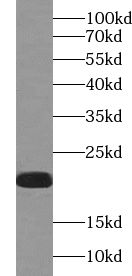GLRX2 antibody - 100 µg
Host : Rabbit
Clonality: Polyclonal
Clone:
Isotype: IgG
Immunogen: glutaredoxin 2
Purity: ≥95% as determined by SDS-PAGE
Form: Liquid
Molecular weight: 16 kDa
Uniprot: Q9NS18
Gene id: 51022
Background: Glutathione-dependent oxidoreductase that facilitates the maintenance of mitochondrial redox homeostasis upon induction of apoptosis by oxidative stress. Involved in response to hydrogen peroxide and regulation of apoptosis caused by oxidative stress. Acts as a very efficient catalyst of monothiol reactions because of its high affinity for protein glutathione-mixed disulfides. Can receive electrons not only from glutathione(GSH), but also from thioredoxin reductase supporting both monothiol and dithiol reactions. Efficiently catalyzes both glutathionylation and deglutathionylation of mitochondrial complex I, which in turn regulates the superoxide production by the complex. Overexpression decreases the susceptibility to apoptosis and prevents loss of cardiolipin and cytochrome c release.
Field of research: Metabolism
Storage conditions: PBS with 0.02% sodium azide and 50% glycerol pH 7.3, -20°C for 12 months(Avoid repeated freeze
thaw cycles.)
Applications: ELISA, WB
Dilution: WB: 1:500-1:2000
Target: GLRX2
Purification: Immunogen affinity purified
Reactivity: Human, Mouse, Rat

Clonality: Polyclonal
Clone:
Isotype: IgG
Immunogen: glutaredoxin 2
Purity: ≥95% as determined by SDS-PAGE
Form: Liquid
Molecular weight: 16 kDa
Uniprot: Q9NS18
Gene id: 51022
Background: Glutathione-dependent oxidoreductase that facilitates the maintenance of mitochondrial redox homeostasis upon induction of apoptosis by oxidative stress. Involved in response to hydrogen peroxide and regulation of apoptosis caused by oxidative stress. Acts as a very efficient catalyst of monothiol reactions because of its high affinity for protein glutathione-mixed disulfides. Can receive electrons not only from glutathione(GSH), but also from thioredoxin reductase supporting both monothiol and dithiol reactions. Efficiently catalyzes both glutathionylation and deglutathionylation of mitochondrial complex I, which in turn regulates the superoxide production by the complex. Overexpression decreases the susceptibility to apoptosis and prevents loss of cardiolipin and cytochrome c release.
Field of research: Metabolism
Storage conditions: PBS with 0.02% sodium azide and 50% glycerol pH 7.3, -20°C for 12 months(Avoid repeated freeze
thaw cycles.)
Applications: ELISA, WB
Dilution: WB: 1:500-1:2000
Target: GLRX2
Purification: Immunogen affinity purified
Reactivity: Human, Mouse, Rat

